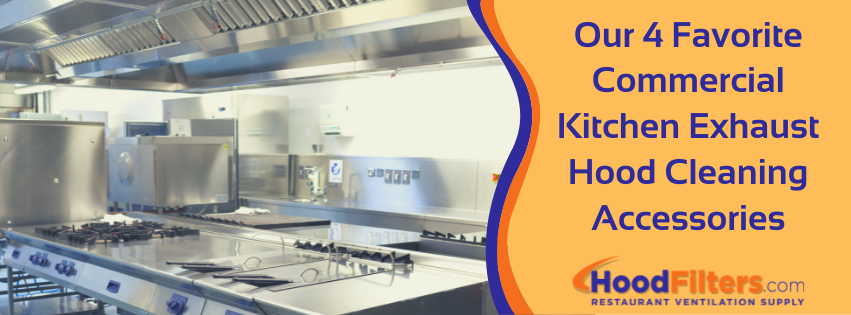Why You Need to Clean Your Commercial Kitchen Exhaust Hood
Your restaurant kitchen exhaust system deals with a steady stream of grease and smoke. This grease, grime, and dirt build up in your system and need to be removed to keep your system in good working order and to reduce risk of fire in your exhaust system. Here are just some of the benefits of keeping your commercial kitchen exhaust system clean. ▪Enhances airflow ▪Reduces risk of fire ▪Reduces risk of grease-related slip and fall accidents ▪Enhances and improves overall hygiene of your restaurant ▪Saves you money (reduces fire risk, equipment runs more efficiently & has longer lifespan) ▪Keeps you in compliance with various regulations and ordinances such as NFPA 96 ▪Exhaust system runs more quietlyHow Often Do I Have to Clean My Commercial Kitchen Exhaust Hood?
The frequency with which you have to clean your commercial hood and exhaust system is set forth by the NFPA along with their regulations and requirements for hood cleaning. Here are the general guidelines for kitchen exhaust cleaning frequency according to the NFPA:Monthly Commercial Kitchen Exhaust Hood Cleaning
The NFPA recommends that restaurants, kitchens or other cooking operations that use solid fuel should clean their ventilation hoods once every month. Solid fuel is any solid material being burned for cooking, most commonly including wood and charcoal.
Quarterly Commercial Kitchen Exhaust Hood
Restaurant and commercial kitchen operations with a high-volume but no solid fuel can lessen the frequency of their exhaust hood cleaning to quarterly. The majority of restaurants will typically fall into this category.
Semi-Annual Commercial Kitchen Exhaust Hood Cleaning
Restaurants and commercial kitchens with a moderate or below volume of cooking operations will qualify for semi-annual cleaning.
Annual Commercial Kitchen Exhaust Hood Cleaning
For low-volume cooking operations (think church, day camp, seasonal business or restaurant) an annual cleaning of the exhaust system will usually be sufficient.
The guidelines above are only a general overview of the NFPA requirements. For more information on NFPA 96, visit the HoodFilters.com Resources Center to download a free copy of our NFPA Fire Code Guide. Please remember that your restaurant may also need to adhere to additional local ordinances, so always check with the municipality where your establishment is located. Learn more about NFPA 96 fire codes for rooftop grease containment in this short video from the experts at HoodFilters.com So now that you have a better understanding of why your commercial kitchen exhaust hood needs to be cleaned and how often you should be cleaning it, let’s talk about five of our favorite hood cleaning accessories for making your work more effective and more efficient!1. Plastic Sheeting
Before cleaning your hood system, you need to wrap the parts of your kitchen that you are not actively going to be cleaning to protect it from overspray. Without plastic sheeting, you’re setting yourself up for an even larger cleanup job! In addition, it also protects other electronic kitchen equipment that may be located near the hood such as monitors or printers. Pro tips: For the best protection, be sure to use 3mil to 4mil plastic sheeting. Also, direct the runoff flow into a bucket or other container securing the plastic on both your hood and the container. This will protect your flooring, keep grease out of your floor drains, and help ensure you can responsibly dispose of the grease contaminated wastewater.
2. Magnets
What’s the best way to get all that plastic sheeting to stay where you want it? GRIPLOC Magnets. And these aren’t just any magnets. With approximately 75 lbs of pull force each, they have 200 times the pulling force of regular magnets. They can be used to hang plastic sheeting from drop ceiling grids, used to wrap and secure plastic sheeting to protect cooking equipment, and many other uses. GRIPLOC Magnets were created specifically for hood cleaners BY a hood cleaner and they are built to last. While regular magnets can be very brittle, cracking and breaking with regular use, GRIPLOC Magnets are encased with an industrial aluminum to protect them from damage. An added benefit of the aluminum is that it also gives you leverage for easy handling when you remove the magnets.
Pro tip: Need to attach your magnets to a non-magnetic material like an ferritic stainless steel or aluminum? When used in pairs, GRIPLOC Magnets are strong enough to pull through stainless steel!
GRIPLOC Magnets were created specifically for hood cleaners BY a hood cleaner and they are built to last. While regular magnets can be very brittle, cracking and breaking with regular use, GRIPLOC Magnets are encased with an industrial aluminum to protect them from damage. An added benefit of the aluminum is that it also gives you leverage for easy handling when you remove the magnets.
Pro tip: Need to attach your magnets to a non-magnetic material like an ferritic stainless steel or aluminum? When used in pairs, GRIPLOC Magnets are strong enough to pull through stainless steel!

3. High Pressure Hose
Pressure washing your exhaust fan and hood are key parts of cleaning your commercial kitchen exhaust hood. But if you want to maximize the abilities of your power washing equipment, you have to have a good high pressure hose. From valves and fittings to bend restrictors and even the materials used for the inner core, there are many things that can affect the quality of a high pressure hose. You should also note how many layers of high tensile steel wire reinforcement the hose has. Another feature to consider is the outer covering or wrapping of the hose. Is it molded vinyl? Was the wrapping co-extruded? Will it be strong enough to withstand heavy use and exposure to chemicals? You will also need to consider the psi pressure rating and temperature rating of the hose.



